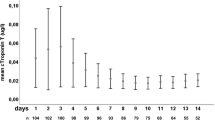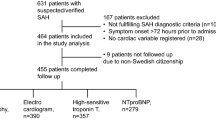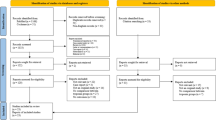Abstract
Objective
Elevated troponin levels are a common occurrence after ischemic stroke and subarachnoid hemorrhage (SAH), and have been described as a neurogenic form of myocardial injury. The prognostic significance of this event is controversial with numerous studies citing conflicting results. The importance of cardiac stress is of particular relevance in the operative management of intracerebral hemorrhage (ICH). To this end, we investigated whether troponin levels were an independent predictor of in-hospital mortality from all causes in surgically treated ICH patients.
Methods
We performed a retrospective analysis of 110 patients admitted to Columbia Presbyterian hospital between 1999 and 2007 for ICH and subsequent clot evacuation. Those with angina or recent myocardial infarction were excluded. CT scans were reviewed to determine hematoma size, location, presence of intraventricular hemorrhage (IVH) or SAH, hydrocephalus, and midline shift. Hospital records were examined for known demographic and clinical predictors of mortality. Univariate analysis was used to screen for predictive factors (P ≤ 0.20) and these variables were entered into the final multivariable logistic regression model along with gender and age.
Results
Of 110 patients, 10 were excluded due to insufficient records or pre-existing cardiovascular disease. Ninety-five patients had at least one troponin level and 83 had multiple levels. Univariate analysis revealed nine factors that predicted in-hospital mortality (P < 0.20): smoking, volume of hemorrhage, midline shift, IVH, neurological status on admission, admission troponin, post-surgical troponin, warfarin use, and international normalized ratio. Only two factors were significant in the final multi-variate model: admission troponin and volume of hemorrhage. Admission troponin levels were a significant risk factor for in-hospital mortality even after controlling for hemorrhage volume, gender, and age.
Conclusions
Elevated cardiac troponin levels are predictive of mortality in surgically treated ICH patients and should be considered in management decisions. Implementation of cardio-protective strategies may improve outcomes in this patient population.
Similar content being viewed by others
References
Baroldi G. Anatomy and quantification of myocardial cell death. Methods Achiev Exp Pathol. 1988;13:87–113.
Broderick JP, Brott TG, Duldner JE, Tomsick T, Huster G. Volume of intracerebral hemorrhage. A powerful and easy-to-use predictor of 30-day mortality. Stroke. 1993;24:987–93.
Caplan LR. Intracerebral haemorrhage. Lancet. 1992;339:656–8.
Connor RC. Myocardial damage secondary to brain lesions. Am Heart J. 1969;78:145–8.
Doshi R, Neil-Dwyer G. Hypothalamic and myocardial lesions after subarachnoid haemorrhage. J Neurol Neurosurg Psychiatry. 1977;40:821–6.
Doshi R, Neil-Dwyer G. A clinicopathological study of patients following a subarachnoid hemorrhage. J Neurosurg. 1980;52:295–301.
Hays A, Diringer MN. Elevated troponin levels are associated with higher mortality following intracerebral hemorrhage. Neurology. 2006;66:1330–4.
Kaye MP, McDonald RH, Randall WC. Systolic hypertension and subendocardial hemorrhages produced by electrical stimulation of the stellate ganglion. Circ Res. 1961;9:1164–70.
Kono T, Morita H, Kuroiwa T, Onaka H, Takatsuka H, Fujiwara A. Left ventricular wall motion abnormalities in patients with subarachnoid hemorrhage: neurogenic stunned myocardium. J Am Coll Cardiol. 1994;24:636–40.
Mangano DT. Perioperative cardiac morbidity. Anesthesiology. 1990;72:153–84.
Mayer SA, LiMandri G, Sherman D, Lennihan L, Fink ME, Solomon RA, et al. Electrocardiographic markers of abnormal left ventricular wall motion in acute subarachnoid hemorrhage. J Neurosurg. 1995;83:889–96.
Mendelow AD, Gregson BA, Fernandes HM, Murray GD, Teasdale GM, Hope DT, et al. Early surgery versus initial conservative treatment in patients with spontaneous supratentorial intracerebral haematomas in the International Surgical Trial in Intracerebral Haemorrhage (STICH): a randomised trial. Lancet. 2005;365:387–97.
Naidech AM, Kreiter KT, Janjua N, Ostapkovich ND, Parra A, Commichau C, et al. Cardiac troponin elevation, cardiovascular morbidity, and outcome after subarachnoid hemorrhage. Circulation. 2005;112:2851–6.
Parekh N, Venkatesh B, Cross D, Leditschke A, Atherton J, Miles W, et al. Cardiac troponin I predicts myocardial dysfunction in aneurysmal subarachnoid hemorrhage. J Am Coll Cardiol. 2000;36:1328–35.
Samuels MA. Neurogenic heart disease: a unifying hypothesis. Am J Cardiol. 1987;60:15J–9J.
Todd GL, Baroldi G, Pieper GM, Clayton FC, Eliot RS. Experimental catecholamine-induced myocardial necrosis. I. Morphology, quantification and regional distribution of acute contraction band lesions. J Mol Cell Cardiol. 1985;17:317–38.
Zaroff JG, Rordorf GA, Ogilvy CS, Picard MH. Regional patterns of left ventricular systolic dysfunction after subarachnoid hemorrhage: evidence for neurally mediated cardiac injury. J Am Soc Echocardiogr. 2000;13:774–9.
Author information
Authors and Affiliations
Corresponding author
Rights and permissions
About this article
Cite this article
Garrett, M.C., Komotar, R.J., Starke, R.M. et al. Elevated Troponin Levels are Predictive of Mortality in Surgical Intracerebral Hemorrhage Patients. Neurocrit Care 12, 199–203 (2010). https://doi.org/10.1007/s12028-009-9245-5
Received:
Accepted:
Published:
Issue Date:
DOI: https://doi.org/10.1007/s12028-009-9245-5




